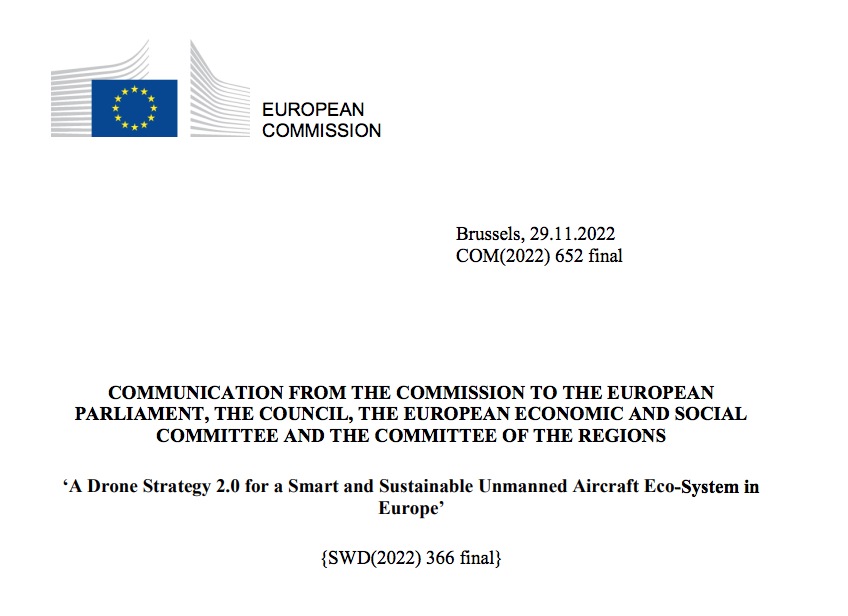The European Union has the ambition to lead the transition towards a healthy planet and a new digital world and for this it has published the revised strategic plan for the creation of a large-scale European drone market.
In fact, the objective of the European Green Deal is to achieve climate neutrality by 2050, so the digitization of the economy should strengthen the European Union's capacity for competitiveness and empower people with a new generation of technologies, including find drones or UAS, on which the Commission has been working since 2014.
Drones are already used as everyday tools in an increasing variety of data-intensive applications, such as agriculture, construction, surveillance and security, audiovisual, healthcare, emergencies, industrial inspections or in the energy or environment sector. Drones could be used in the future as well, for example, as platforms for communication centers or for pollution control or for the maintenance of renewable energy installations.
In the transport sector, the use of drones for small parcel deliveries is already being tested in many countries. The first pilot tests in passenger transport on the European Union continent are expected to be carried out in the coming years. It is therefore important that the European Union safeguard its strategy in this area.
With the proper framework established, the drone services market in Europe could reach a value of 14.5 billion euros by 2030, with a compound annual growth rate of 12.3%, and create 145,000 jobs in the EU28. The different segments of this market are constantly growing in terms of companies and volume of operations.
This strategy covers ten areas that should unfold the development of the drone ecosystem and help achieve the objectives set, which have been identified on the basis of the information received during extensive consultations that are described in the working document of the staff of the different committees. of experts.
Those areas are grouped under two main objectives.
- The first is to build the Union drone services market
- The second is to strengthen the Union's civil security and defense industry capabilities and synergies.
Each area aims to strengthen the efficiency of the different segments of the overall drone value chain, from drone operators, drone manufacturers, the defense sector, or the provision of services for U-Space.
The 10 areas covered by the Commission's strategy, divided between creating the market for drone services (A) and strengthening European civil, security and defense industry capabilities and synergies (B) are:
1- Improvement of airspace capabilities (development and integration of U-Space with Air Traffic Management).
2- Facilitating air operations.
3- Development of innovative air mobility.
4- Guarantee sustainability and social acceptance.
5- Promote the human dimension and its associated factors (knowledge, training, skills, competencies).
6- Provide funds and financing.
7- Identify strategic technological components and technological enablers.
8- Enabling tests and demonstrations.
9- Promoting common standards.
10- Increased capabilities against drones and system resilience
To achieve the proposed objectives, the following actions are defined to be carried out:
- The Commission intends to adopt amendments to the European Air Regulations and Air Traffic Management/Air Navigation Services Regulations to safely integrate piloted drone and eVTOL operations.
- The Commission will continue to promote coordinated research on integrated Communication, Navigation and Surveillance technologies to ensure convergence between ATM and U-space environments.
- The Commission intends to adopt new European standard scenarios for low to medium risk air operations.
- The Commission intends to adopt standards for the certified category of drone operations, addressing the initial and continuing airworthiness of drones subject to certification and the operational requirements applicable to VTOL-capable UAS.
- The Commission intends to adopt rules for the design and operations of vertiports under the scope of the EASA Basic Regulation.
- The Commission intends to develop economic balance and financial requirements for the licensing of drone operators.
- The Commission will finance the creation of an online platform to support a sustainable implementation of IAM by authorities, communities, municipalities, industry and stakeholders.
- The Commission intends to adopt new training and competency requirements for remote pilots and pilots of VTOL aircraft.
- The Commission intends to continue providing funding for drone R&D and its integration into airspace under the Horizon Europe program and the European Defense Fund.
- The Commission intends to establish a coordinated series of calls
under existing EU instruments and EIB loans to support a new flagship project on 'drone technologies'.
- The Commission will consider possible amendments to the current funding to ensure a coherent approach in support of dual-use research and innovation to enhance synergies between civil defense and defense instruments.
- The Commission intends to develop a strategic drone technology roadmap to identify priority areas to boost research and innovation, reduce existing strategic dependencies and prevent the emergence of new ones.
- The Commission intends to coordinate with other relevant EU bodies
with the goal of providing sufficient radio frequencies within the spectrum for drone operations.
- The Commission intends to create an EU network on civil protection with drone test centers to facilitate exchanges between the civil and defense sectors.
- The Commission will encourage all relevant actors to continue to harmonize certification requirements for civil and military applications against those established by EASA considering military specificities and military certification.
- The Commission intends to adopt new standard scenarios for operations that could facilitate military use cases.
- The Commission intends to adopt a package of counter-drone systems (C-UAS).
- The Commission intends to adopt an aviation amendment on safety standards to ensure that aviation authorities and airports increase their resilience to the risks posed by drones.
- The Commission intends to define the criteria for a “European Trusted Drone” Label.
https://transport.ec.europa.eu/news/drone-strategy-creating-large-scale-european-drone-market-2022-11-29_en


